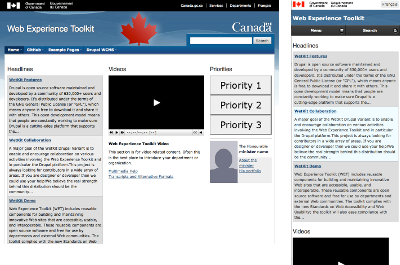Drupal 7 WET/WxT Variant - The Government of Canada's Distribution
on
We've been strategizing, evaluating & deploying the Government of Canada's (GoC) Drupal 7 Web eXperience Toolkit (WxT) since it was first released over a year ago. We've implemented this for government agencies inside & outside the GoC because it is clear that so many agencies need to meet the dual challenge of a site which is both bilingual & accessible.
The Drupal Variant of the Web eXperience Toolkit is an open platform for web publishing which has a critical mass of public sector agencies collaborating with it publicly in GitHub. It is also exciting to see institutions like the University of Ottawa adopting it because of their need to ensure that their website is fully bilingual and meets WCAG 2.0 AA.
WET/WxT needs some explanations as this is a project implemented by the Treasury Board Secretariate (TBS) to produce a static template for all GoC sites which meets their usability, accessibility & branding requirements. TBS has been actively engaging with governments of the world looking to both share & get further buy-in. What is Unique about their approach is that there is a commitment to keep up with usability & accessibility best practices every 6 months. Anyone who is watching their browser traffic knows how quickly user patterns can change in a year. Using only HTML5, CSS & Javascript, their challenge has been to a build CMS-agnostic template for all 151 million public GoC web pages. WxT is also designed to be responsive so you can serve your site effectively to your users no matter what device they are using.
 The Drupal Variant integrates these best practices into Drupal in a way that makes it easier for content owners to leverage this work. In the past, the most a government department needed to meet the Web Standards for the Government of Canada was to have a CLF Officer ensure that all of the points in the Common Look & Feel documentation were included in all public materials. By coding best practices into the distribution & having a repository of both issues & documentation it is becoming much easier to be certain about what is needed to be compliant.
The Drupal Variant integrates these best practices into Drupal in a way that makes it easier for content owners to leverage this work. In the past, the most a government department needed to meet the Web Standards for the Government of Canada was to have a CLF Officer ensure that all of the points in the Common Look & Feel documentation were included in all public materials. By coding best practices into the distribution & having a repository of both issues & documentation it is becoming much easier to be certain about what is needed to be compliant.
Collaboration within most public sector agencies unfortunately requires a culture change to allow developers & designers to engage across the silos. It's been a very exciting project to be involved in, both because of the code developed and the connections that people are now able to make with each other outside of their department. In the last 6 months we've seen a dramatic increase of departments sharing resources, code & ideas to help them build the websites they need. This Drupal distribution has become the most active means for public agencies on all levels to work together to meet their publishing needs.
The WxT Distribution extends the accessibility that we worked hard to bring into Drupal 7. Meeting accessibility requirements is difficult and can require hundreds of days to audit & evaluate effectively. By working from a common platform, many of the barriers to participation will already be resolved before an accessibility audit is begun.
This distribution has included workflow, usability, migration, performance & security enhancements. After careful consideration, this distribution has adopted AdaptiveTheme & Panopoly which are being widely used and extended by many other popular distributions. As a Drupal Core Maintainer I've been contributing with Drupal 8 since it was started and it is exciting to see some of the ideas from Drupal 8 being brought back into a Drupal 7 distribution. This will really help users have an easier migration path in 2-3 years.
Share this article
About The Author
Mike Gifford is the founder of OpenConcept Consulting Inc, which he started in 1999. Since then, he has been particularly active in developing and extending open source content management systems to allow people to get closer to their content. Before starting OpenConcept, Mike had worked for a number of national NGOs including Oxfam Canada and Friends of the Earth.



